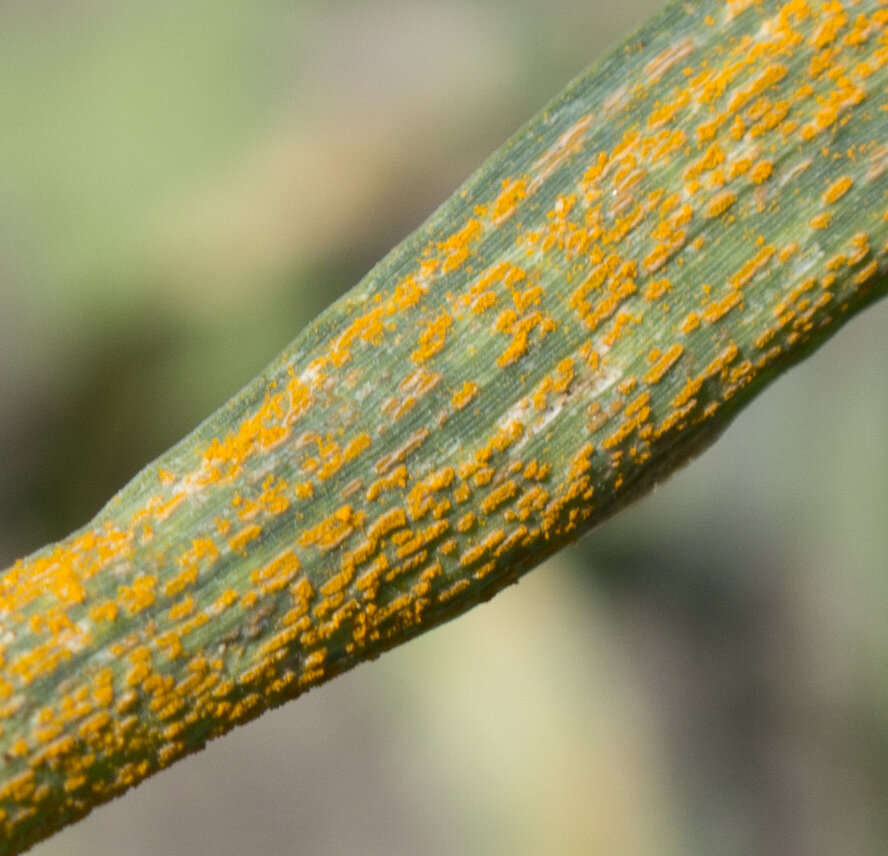Untangling the mystery of robust rust resistance

By Clare Stanfield
The rust resistance gene pool can is large and complicated. More than 200 known genes confer resistance to leaf, stem, and stripe rust that wheat breeders use to develop rust-resistant varieties. Despite the number of potential paths to rust-resistance, many producers have experienced a rust-resistant wheat variety suddenly stop working. This raises the question: Do any of the 200-plus rust-resistant genes have the potential to be a long-term, stable solution to rust-resistance?
Wentao Zhang, a research officer at the National Research Council of Canada (NRC) in Saskatoon, says the issue isn’t with the resistant genes themselves but how we have been using them. “The genetics of these resistant genes is less understood and most of them have been introgressed into cultivars in a ”˜blind’ way,” he says.
In other words, genes that confer resistance to various types and strains of rust are found and then added into germplasm for a wheat variety without knowing the gene’s long-term viability. Often, rust pathogens quickly adapt, evolve, and break down the resistance.
Like any genes in a complex biological system, the rust-resistant genes influence each other and the plant they belong to in a myriad of ways researchers don’t fully understand yet.
With funding from the Saskatchewan Wheat Development Commission and Saskatchewan Ministry of Agriculture’s Agriculture Development Fund, Zhang and a team of collaborators from Agriculture and Agri-Food Canada (AAFC) and the University of Saskatchewan (USask) undertook a research project to understand rust-resistant mechanics and gene interactions that may lead to robust rust resistance in wheat.

Breaking down the genetic details
Genes responsible for conferring rust resistance can be arranged into two main groups. Resistant (R) genes tend to be specific to a single race or disease isolate. While they function through the plant’s entire life cycle, they break down quickly. Adult plant resistant (APR) genes activate once plants reach adult growth stages, often after disease develops. However, some APR genes give resistance to all races, or isolates, of a single rust pathogen, and many even include other disease pathogens in their orbit.
Zhang’s study was aimed at identifying the resistance mechanisms in two wheat varieties: Parula, which has shown high levels of resistance to all three types of rust, and Thatcher, which has shown some APR resistance to stem rust. The goal was to characterize this resistance so wheat breeders could target these mechanisms in their breeding programs.
Characterizing resistance requires identifying QTLs, or quantitative trait loci. “QTL mapping is finding where resistance is located on the genome,” explains Kerry Boyle, technical officer with NRC in Saskatoon and Zhang’s colleague on this project. QTL analysis can give researchers a picture of which regions of the plant genome contribute the most to resistance and how genes interact.
Zhang started by crossing Parula and Thatcher. “We know these lines show resistance in the field,” says Zhang, adding that genotyping and QTL analysis would hopefully reveal which genes were doing most of the work, and what combinations of R and APR genes would present more durable rust resistance.
Populations of the Parula/Thatcher cross were exposed to rust in three AAFC disease nurseries: The Morden nursery for leaf rust, the Brandon nursery for stem rust, and the Lethbridge nursery, along with a nursery at USask, for stripe rust. In all, 306 double haploid lines of Parula/Thatcher wheat were examined with the results verified through field testing.
Gradually, Boyle and Zhang built up a genetic map that showed where these APR genes were on the wheat genome and gained a better understanding of how they behaved, how they interacted with each other and the growing environment, and what their level of contribution was to rust resistance. “We have a better idea of these things, but we are very far from knowing it all,” says Boyle.
Building a better pyramid
The overall goal was to determine which combinations of resistant genes, stacked together or “pyramided,” would deliver more durable resistance in wheat.
“We think that if you have three APR genes, that’s a good foundation. This should be durable,” says Zhang. He has identified a “foundational multi-APR cassette” that names specific APR genes that can be used to produce durable resistance to all three types of rust found in Canada.
The project also discovered a small number of stem, leaf, and stripe rust-resistant genes previously unknown to breeders. “A lot more work needs to be done to characterize those,” says Zhang. Boyle says that one of the more important QTLs they found affects grain quality and is linked to fusarium susceptibility.
Does all this discovery mean that reliable, rust-resistant wheat varieties will be available soon? “Not yet,” says Zhang. “But the [genetic] markers were published, and this can be useful to breeders to check their breeding lines. Now they can use these markers to ensure they retain good genes during the breeding process.”